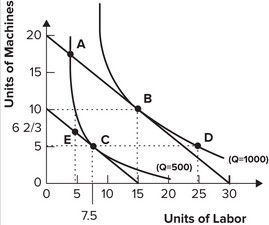Refer to the graph shown. The most economically efficient way to produce 1,000 units of output is to use:
A. 5 units of machines and 25 units of labor.
B. 5 units of machines and 7.5 units of labor.
C. 6 and 2/3 units of machines and 5 units of labor.
D. 10 units of machines and 15 units of labor.
Answer: D
You might also like to view...
If Year 1 is the base year, the GDP price deflator for Year 2 is approximately
A) 100.0. B) 126.3. C) 131.3. D) 181.0.
One way to view the cost structure of monopolistic competition is to say that the cost of product differentiation is equal to
A) the difference between marginal revenue and marginal cost. B) the difference between the cost of production for a monopolistically competitive firm in an open market and the minimum average total cost. C) the sum of price and marginal cost. D) the sum of marginal cost and minimum average cost.
As the price of a good rises, the consumer will experience
A) a desire to consume a different bundle. B) a decrease in utility. C) a southern or western movement on the indifference map. D) All of the above.
The key part of the real business cycle theory model is:
A. changes in potential output. B. changes in aggregate demand. C. the short-run aggregate supply curve. D. the importance of monetary policy.